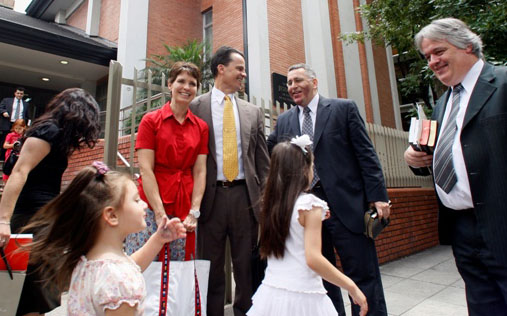A recent study by the national Public Religion Research Institute found that Cache County had America’s third-highest concentration of members of the Church of Jesus Christ of Latter-day Saints with 64 percent of residents reporting that religious affiliation.
WASHINGTON, D.C. – Utah’s 1st Congressional District has long been recognized as one of the most solidly conservative and Republican areas of the United States.

Now the Public Religion Research Institute (PRRI) has indicated that the nine-county area that makes up Utah’s 1st District also has one of America’s highest combined percentages of members of the Church of Jesus Christ of Latter-day Saints.
Coincidence? Not likely.
“The religious make-up of an area has a considerable influence on life experiences for Americans,” explains Natalie Jackson, the PRRI research director. “We are proud to release the 2020 Census of American Religion, which enables us to see that religious landscape all the way down to county level.”
Utah’s 1st Congressional District sprawls over much of the northern portion of the state, including Box Elder, Cache, Daggett, Morgan, Rich, Summit, Uintah and Weber counties, plus parts of Davis County.
The 1st District hasn’t sent a Democrat to Congress in more than 40 years and decisively gave its votes to President Donald Trump in both 2016 and 2020.
It’s no surprise that the recent PRRI survey found that America’s highest concentration of Latter-day Saint church members anywhere in the country was in Utah County, where 72% of residents belong to the Church of Jesus Christ of Latter-day Saints. The religious census found the second-highest concentration of Latter-day Saints is in Madison County, Idaho, the home of Brigham Young University-Idaho. But Cache County came in third in that headcount.
In fact, three of the nine counties in the 1st Congressional District are in the PRRI’s top-ten list for the highest percentages of Latter-day Saints and other neighboring northern Utah counties are not far behind.
The 1st District counties in that top-ten list are Cache (with 64% of residents being Latter-day Saints), Morgan (with 61%) and Box Elder (with 60%).

In April, Russell M. Nelson, President of the Church of Jesus Christ of Latter-day Saints, announced that a new temple for the church would be built in Smithfield. In addition to another temple that had been announced for Syracuse, there are four operational temples for the church in the 1st Congressional District (Logan, Brigham City, Ogden and Vernal) with two additional announced (Smithfield and Syracuse).
Across the border in Idaho, 43% of Franklin County residents claim to be members of the church; 37% in Bear Lake County; and, 32% in Oneida County.
Of the remaining six counties in Utah’s 1st Congressional District, four have at least 50 percent of their residents reporting themselves to be members of the Church of Jesus Christ of Latter-day Saints (Davis, 57%; Rich, 53%; Uintah, 51%; and Weber, 50%).
In Daggett and Summit counties, however, church membership is reported as 38% and 36% respectively.
Only 16 percent of church members identify as Democrats, according to the recent PRRI survey. That means of nearly a half-million church members living in the 1st Congressional District, only about 75,000 are likely to vote for a liberal or Democratic candidate.

The religious homogeneity of Utah’s 1st Congressional District tends to mirror national trends. The PRRI 2020 census found that religious diversity tends to be highest in urban counties. Religious homogeneity is more often found in suburban and rural counties, like most of those in the 1st District.
The PRRI’s 2020 Census of American Religion also studied other U.S. religious groups, including Evangelicals; mainline Protestants and Catholics; Muslims; Jews; Buddhists; and, Hindus.
PRRI is a non-partisan, non-profit group dedicated to conducting independent research exploring the intersection of religion, culture and politics.
Its 2020 Census of American Religion is based on interviews conducted with more than 450,000 adult Americans between 2013 and 2020.
The most recent of those interviews were conducted by telephone with a random sample of 50,000 adults in both English and Spanish between February and November of 2020. The margin of error in that sample is plus or minus .5 percent.

